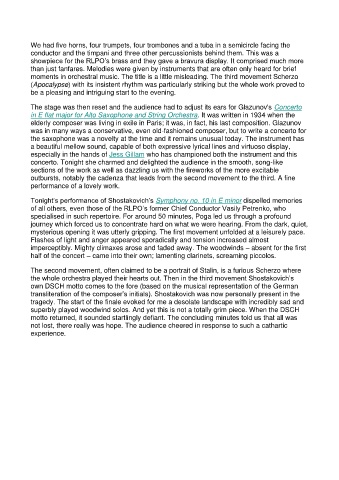Page 354 - Liverpool Philharmonic 22-23 Season Coverage Book
P. 354
We had five horns, four trumpets, four trombones and a tuba in a semicircle facing the
conductor and the timpani and three other percussionists behind them. This was a
showpiece for the RLPO’s brass and they gave a bravura display. It comprised much more
than just fanfares. Melodies were given by instruments that are often only heard for brief
moments in orchestral music. The title is a little misleading. The third movement Scherzo
(Apocalypse) with its insistent rhythm was particularly striking but the whole work proved to
be a pleasing and intriguing start to the evening.
The stage was then reset and the audience had to adjust its ears for Glazunov's Concerto
in E flat major for Alto Saxophone and String Orchestra. It was written in 1934 when the
elderly composer was living in exile in Paris; it was, in fact, his last composition. Glazunov
was in many ways a conservative, even old-fashioned composer, but to write a concerto for
the saxophone was a novelty at the time and it remains unusual today. The instrument has
a beautiful mellow sound, capable of both expressive lyrical lines and virtuoso display,
especially in the hands of Jess Gillam who has championed both the instrument and this
concerto. Tonight she charmed and delighted the audience in the smooth, song-like
sections of the work as well as dazzling us with the fireworks of the more excitable
outbursts, notably the cadenza that leads from the second movement to the third. A fine
performance of a lovely work.
Tonight’s performance of Shostakovich’s Symphony no. 10 in E minor dispelled memories
of all others, even those of the RLPO’s former Chief Conductor Vasily Petrenko, who
specialised in such repertoire. For around 50 minutes, Poga led us through a profound
journey which forced us to concentrate hard on what we were hearing. From the dark, quiet,
mysterious opening it was utterly gripping. The first movement unfolded at a leisurely pace.
Flashes of light and anger appeared sporadically and tension increased almost
imperceptibly. Mighty climaxes arose and faded away. The woodwinds – absent for the first
half of the concert – came into their own; lamenting clarinets, screaming piccolos.
The second movement, often claimed to be a portrait of Stalin, is a furious Scherzo where
the whole orchestra played their hearts out. Then in the third movement Shostakovich’s
own DSCH motto comes to the fore (based on the musical representation of the German
transliteration of the composer’s initials). Shostakovich was now personally present in the
tragedy. The start of the finale evoked for me a desolate landscape with incredibly sad and
superbly played woodwind solos. And yet this is not a totally grim piece. When the DSCH
motto returned, it sounded startlingly defiant. The concluding minutes told us that all was
not lost, there really was hope. The audience cheered in response to such a cathartic
experience.

